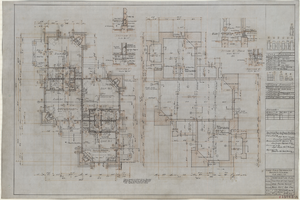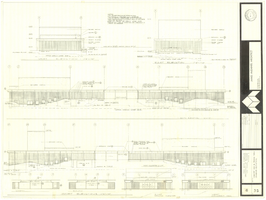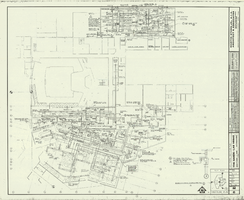Search the Special Collections and Archives Portal
Search Results

Architectural drawing of four room deluxe cabin at Bryce Canyon National Park, Utah, foundation and floor plans, March 5, 1929
Date
Description
Floor plans, foundation plans and sections for deluxe cabin at Bryce Canyon National Park, Utah. Scale 1/4"". Sheet 1#, Job. No. 499, Date 3-5-29. Dr.: Weldon. Tr: Weldon, Ck.: A.S. Revision No. 1, 4/11/29 by [P.R.] Gage. #15763-A
Site Name: Bryce Canyon National Park (Utah)
Image

Architectural drawing of four room deluxe cabin at Bryce Canyon National Park, Utah, elevations and sections, roof plan, March 5, 1929
Date
Description
Exterior elevations, roof plan, sections A, B, C for deluxe cabin at Bryce Canyon National Park, Utah. Scale 1/4". Sheet 2, Job no. 499, date 3-5-29. Dr.: Weldon. Tr.: Weldon. Ck.: A.S. Revision No. 1, 4/11/29 by [P.R.] Gage. #15763-B
Site Name: Bryce Canyon National Park (Utah)
Image

Architectural drawing of cabin at Bryce Canyon National Park, Utah, bed and dresser details, April 25, 1924
Date
Description
Exterior elevations, sections, details for cabin at Bryce Canyon National Park. Scales shown on plan. Dr. by E.A.L. Tr. by E.A.L. Sheet #1, Job #259U. 4-25-24. Revised Aug. 27, 1924, Dec. 29, 1924, March 27, 1928. File no. 15181-I.
Site Name: Bryce Canyon National Park (Utah)
Image

Architectural drawing of addition to pavilion at Bryce Canyon National Park, Utah, foundation plan details, February 19, 1926
Date
Description
Foundation plan, sections A-O, window and door schedules for pavilion at Bryce Canyon National Park, Utah, including additions. ""Scale 1/4"" & 1/2""."" Dr. by Brown. Tr. by Brown. Ch. by P.R. Gage. Sheet no. 3, Job no. 350, date 2-19-26. Revised 6-14-26. #15774-C.
Site Name: Bryce Canyon National Park (Utah)
Image

Architectural drawing of addition to pavilion at Bryce Canyon National Park, Utah, first floor plan, February 19, 1926
Date
Description
First floor plan for pavilion at Bryce Canyon National Park, Utah, including additions. "Line G continued from Sheet no. [4]." Dr. by Brown. Tr. by Brown. Ch. by P.R. Gage. Sheet no. 5, Job no. 350, date 2-19-26. Revised 6-14-26. #15774-E.
Site Name: Bryce Canyon National Park (Utah)
Image

Architectural drawing of concert hall and drama theater, University of Nevada, Las Vegas, exterior elevations, November 5, 1969
Date
Archival Collection
Description
Exterior elevations for the concert hall and drama theater on the University of Nevada, Las Vegas campus, including a connecting courtyard. These buildings would become the Artemus W. Ham Concert Hall and the Judy Bayley Theatre. Sheet 6 of 35. "Drawn by G.T. Checked by K.D. Job number 6828. Scale 1/16" = 1'-0". Date Nov. 5, 1969"
Site Name: University of Nevada, Las Vegas
Address: 4505 S. Maryland Parkway
Image

Architectural drawing of additions and alterations to the mens' and womens' health clubs in the Sands Hotel, Las Vegas, Nevada, April 19, 1965
Date
Description
Floor plans, sections, elevations for mens' and womens' health clubs at the Sands Hotel, Las Vegas, Nevada. Includes door and finish schedules. "Sheet no. 17A. Job no. 420. Drawn by Shoji Yasuda. Job captain, Mas Tokubo. 2-26-65. Revised 4-19-65."
Site Name: Sands Hotel
Address: 3355 Las Vegas Boulevard South;
Image

Architectural drawing of additions and alterations to first floor air conditioning piping in the Sands Hotel, Las Vegas, Nevada, November 4, 1965
Date
Description
Additions and alterations to first floor air conditioning and piping in the Sands Hotel, Las Vegas, Nevada. Includes details of dishwasher piping and humidifier piping, and equipment notes. "Sheet number M2. Job number 420. Job captain, D.G. Checked by D.G. Consultant: Hellman & Lober, Mechanical Engineers." "August 3, 1964. Revised 8-14-64, 11-4-65."
Site Name: Sands Hotel
Address: 3355 Las Vegas Boulevard South;
Image

Architectural drawing of partial additions and alterations to first floor air conditioning in the Sands Hotel, Las Vegas, Nevada, August 13, 1965
Date
Description
Partial plan of additions and alternations to the air conditioning system on the first floor of the Sands Hotel, Las Vegas, Nevada."Sheet number M6. Job 420. Scale: 1/8"=1'0. Drawn by KKSH. Job captain: D.G. Checked by D.G. Date: 8-3-1964. Revisions 8/14/64; 8/31/64; 11/6/64; 1/12/65; 3/12/65; 4/12/65; 8/13/65. Consultant: Hellman & Lober, Mechanical Engineers."
Site Name: Sands Hotel
Address: 3355 Las Vegas Boulevard South;
Image

Architectural drawing of additions and alterations to first floor plumbing, Sands Hotel, Las Vegas, Nevada, January 20, 1967
Date
Description
Plan for additions and alterations to the plumbing system on the first floor of the Sands Hotel, Las Vegas. "Sheet number P5. Job 420. Scale: 1/8"-1'0. Drawn by H.C. & R.S. Date 8-3-64. Revisions: 8-31-64; 9-29-64; 10-27-64; 11-6-64; 12-4-64; 2-26-65; 3-12-65; 4-23-65; 11-4-65; 1-20-67. Consultant: Hellman & Lober, Mechanical Engineers."
Site Name: Sands Hotel
Address: 3355 Las Vegas Boulevard South;
Image
